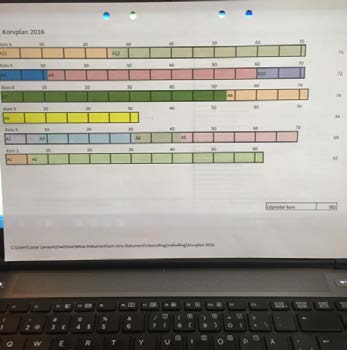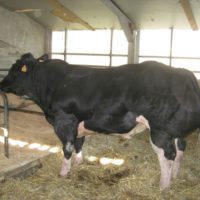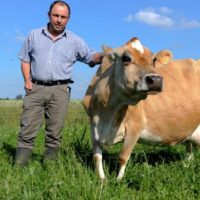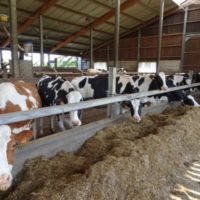Handy Excel spreadsheet for forage inventory, consumption and production
Farm: “Jon-Jon”
Location: Hälsingland, Sweden
Case study
 Handy Excel spreadsheet for forage inventory, consumption and production (.pdf)
Handy Excel spreadsheet for forage inventory, consumption and production (.pdf)
Description
Background
Jon-Jon Farm is situated in a region with a cold continental climate close to Bollnäs in Hälsingland, central Sweden, and has sandy to sandy loam soils. There are 160 Holstein milking cows, which produce 12500 kg milk per year in an automatic milking system with two Delaval robots. The heifers are sent out to a ‘heifer hotel’ on a neighbouring farm. Jon-Jon Farm has 330 ha of productive land (74 ha owned, 256 ha rented), of which 180 ha is temporary grassland cut for silage. Grazing is restricted to 15 ha of exercise pasture. Barley and spring wheat are also grown on the farm.
The leys are sown in pure stands, rather than being undersown, and consist of timothy, festucoid Festulolium, meadow fescue, red clover and white clover. The farm has its own tedder and decides when the grass will be moved from the field. The farm hires machinery for harvesting, chopping and filling silo bags, but has own equipment for hay raking and fertiliser and manure spreading.
The farm is very interested in calculating and monitoring to optimise use of farm resources. It has always had a strategy for monitoring cuts, forage analyses and inventory. Improvements have been made continuously. Computerisation revolutionised the system, with Excel spreadsheets being particularly useful. The Excel spreadsheet is used for making decisions, or when an issue arises.
Good monitoring of feedstuffs allows full stocking rates while knowing that there will still be enough feed. In this way, the farm’s land can also be utilised optimally. Areas near the farm are used for grass production and land farther away for grain production. This reduces the transport costs on the farmed area.
Detailed description
Marking, documenting and calculating for safe, optimised forage usage
On Jon-Jon Farm, the aim is to optimise silage production. Good quality, frequent forage analyses and skill in optimising animal rations are part of this. Cutting costs by producing all silage in areas close to the farm is also an advantage.
In mapping, an account is made of where silage of different types is situated, the amounts and corresponding silage analysis. The silo bags are also marked every 2 m and at the place where a new load or silage analysis begins. Mapping of silo bags and an Excel spreadsheet on silage use make this possible. By entering the total stock of silage in a spreadsheet, the use can be planned until the next harvest, which can be up to a year ahead. If there is a shortage of forage, then it is possible to reduce the ration or the number of cows. An alternative is to fill a smaller first-cut silo bag to be used in summer. This is an economical method to ensure there is enough silage and makes it possible to avoid excess storage of silage.
Results
Precise use of forage and area and confidence in forage supply
Silage is stored in silo bags and a small number of big bales. An accompanying Excel spreadsheet lists where silage corresponding to a certain forage analysis is situated. As the silage is weighed when mixing, it is also possible to calculate total yield of harvested forage. A good computer-based protocol used with good discipline is the key to success.
The system allows several goals to be met simultaneously, e.g. it is possible to avoid excess storage of silage and the current year’s silage can be opened in August. The most important advantage is that it shows whether there will be enough forage. At any time of the year, the farmer can calculate how long the forage will last.
The Excel spreadsheet calculates the date on which the forage will run out. With continuous monitoring, it is fully possible to:
- Reduce the amount of forage in the ration
- Reduce the number of animals by culling
- Buy forage from a partner farm
- Make a wetter ‘summer silo bag’ to complement the forage ratio until the year’s silage is opened in August.
Adoption criteria
A system that requires precision
This innovation is suitable for farms actively seeking to optimise their production. The system as a whole requires an interest in calculations in general and calculations using Excel spreadsheets in particular. Storing silage in silo bags is the starting point, as it suits the monitoring system. However, few farms store all their silage in silo bags.
It is also possible to adopt parts of the concept. Marking where forage samples are taken, e.g. where a new batch begins, is easy to do. The feeding-out rate can be checked by noting how many metres of silo bag are used in a certain number of days. This can be used as the basis for other calculations.
To exploit the system to the full, all those involved in production need to be prepared to contribute. During harvesting, it is important that the person responsible for silo packing makes a mark with a pen after every load and also marks where samples have been taken for forage analysis.
Future prospects
Important to involve staff in the process
Jon-Jon Farm uses a monitoring system that has been developed over many years and is practically fully mature. However new ideas or question may arise, in which case the Excel spreadsheets can be used for decision support.
There are also risks in the silo bag system, e.g. filling must function well and the bags must be laid within a limited area and on a good surface. Precision in packing is important.
The farm has long-term employees who have been working on the system for a while, and this helps towards the success of the system. A good contractor does the packing, which is also important. The farm also uses a feeding advisor, who helps to formulate an optimal ration.
Additional information
| Farming system | conventional farming |
|---|---|
| Domains of innovation | animal feeding management, farm system, forage conservation technique |
| Main types of animal | dairy cattle |
| Country | Sweden |
| Product type | Case study |
| Language | English |
| Author | Nilla Nilsdotter-Linde |







